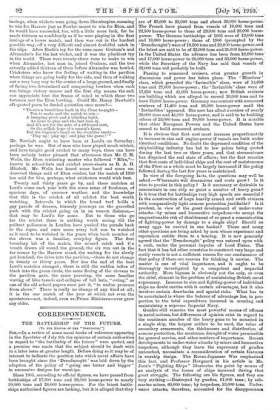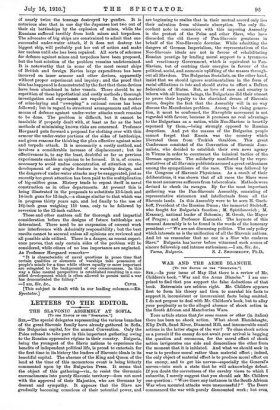CORRESPONDENCE.
THE BATTLESHIP OF THE / ITo TSB EDITOR Or THE " SPECTATOR."' Slit,-In a review of some naval books of reference appearing in the Spectator of July 9th the opinions of certain authorities in regard to "the battleship of the future" were quoted, and a promise was made that the subject should be dealt with in a later issue at greater length. Before doing so it• may be of interest to indicate the position into which naval affairs have been brought since the Dreadnought' was laid down by the adoption of the policy of " going one better and bigger" in successive designs for warships.
Since 1905, according to official figures, we have passed from battleships of 17,900 tons and 23,000 horse-power to nearly 20,000 tons and 28,000 horse-power. For the latest battle- ships authorised figures are lacking, but it is alleged that they are of 23,000 to 25,000 tons and about 30,000 horse-power.' The French have passed from vessels 'of 18,000 tons and 22,500 horse-power to those of 23,000 tons and 28,000 horse- • power. The German battleships of 1905 were of 13,000 tons and 18,000' horse-power ; thOse of 1906 (prompted by the Dreadnought') were of 18,200 tons and 20,000 horse-power, and the latest are said to be of ,000 tons and 25,000 horse-power.
In the United States the advance has been- from 16,000 tons' and 17,000 horse-power to 26,000 tons and 33,000 horse-power, while the Secretary of the Navy has said that vessels of 32,000 tons will probably be built.
Passing to armoured cruisers, even greater growth in dimensions and power has taken place. The Minotaur
class, which preceded the `Invincible' class, were of 14,600 tons and 27,000 horse-power ; the Invincible' class were of 17,250 tons and 41,000 horse-power; now British cruisers are building which are alleged to exceed 26,000 tons and to have 70,000 horse-power. Germany was content with armoured cruisers of 11,400 tons and 28,000 horse-power until the Invincibles ' appeared. She now has afloat a cruiser of nearly 19,000 tons and 45,000 horse-power, and is said to be building others of 23,000 tons and 70,000 horse-power. It is notable 'that other European Powers and the United States have ceased to build armoured cruisers.
It is obvious that first cost must increase proportionately to increase in size and engine-power if vessels are built under identical conditions. No doubt the depressed condition of the shipbuilding industry has led to low prices being quoted during the last two or three years, and that circumstance has disguised the real state of affairs; but the fact remains that first costs of individual ships and the cost of maintenance of the Fleet as a whole must be largely increased if the policy followed during the last few years is maintained.
In view of the foregoing facts, the questions may well be asked :-Whereunto will dimensions and costs grow ? Is it wise to persist in this policy ? Is it necessary or desirable to concentrate in one ship so great a number of heavy guns F, Is it true that for battleships very high speeds are -essential ?
Is the construction of huge heavily armed and swift cruisers with comparatively light armour protection justifiable ? Is it prudent, in view of the great development of under-water attacks-by mines and locomotive torpedoes-to accept the unquestionable risk of disablement of so great a concentration of fighting-power by damage to a single ship ? Should so many eggs be carried in ene basket? These and many other questions are being asked by men whose experience and reputation entitle them to a hearing. .It is now generally agreed that the Dreadnought' policy was entered upon with a rush, under the personal impulse of Lord Fisher. The fact that it has led other countries to construct very large and
costly vessels is not a sufficient reason for, our continuance of
that policy if there are reasons for thinking it unwise. The matter is one of vital importance, and it ought to be thoroughly investigated by a competent and impartial authority. Mere bigness is obviously not the only, or even the chief, element in the problem of maintaining British naval supremacy. Increase in size and fighting-power of individual ships no doubt carries with it certain advantages, but it also involves certain drawbacks and special risks. What has to
be ascertained is where the balance of advantage lies, in pro- portion to the total expenditure incurred in creating and maintaining a supreme Imperial Navy.
Gunfire still remains the most powerful means of offence in naval actions, but differences of opinion exist in regard to the maximum number of the heavy guns to be mounted in a single ship, the largest calibre to be used, the value of secondary armaments, the thicknesses and distribution of armour protection, the maximum draught of water permissible
for general service, and other matters of importance. Recent developments in under-water attacks by mines and locomotive
torpedoes, although they leave the supremacy of gunfire
untouched, necessitate a reconsideration of certain features in warship design. The Russo-Japanese War emphasised
this fact, and Professor Hovgaard in his article in Mr.
Jane's " Fighting Ships " illustrates the point by means of an analysis of the losses of ships incurred during that great straggle. The following are his figures, and they are very striking :-Destroyed by gunfire, 61,000 tons ; by siab- marine mines, 60,000 tons; by torpedoes, 53,000 tons. Under- water attacks, therefore, accounted for the disappearance of nearly twice the tonnage destroyed by gunfire. It is notorious also that in one day the Japanese lost two out of their six battleships by the explosion of mines, while the Russians suffered terribly from both mines and torpedoes. The advocates of big ships are constrained to admit that one successful under-water attack, if it does not destroy the biggest ship, will probably put her out of action and make her useless until she has been repaired. All sorts of schemes for defence against mines and torpedoes have been proposed, but the beat solution of the problem remains undetermined. It is noteworthy that in some of the most recent ships of British and foreign Navies large expenditure has been incurred on inner armour and other devices, apparently without proper experiment and inquiry ; and the proof that this has happened is demonstrated by the fact that these devices have been abandoned in later vessels. There should be no repetition of these hypothetical and costly methods ; thorough investigation and experiment are required. In the matter of mine-laying and "sweeping" a rational course has been followed; but in regard to structural arrangements and other means of defence against under-water attacks much remains to be done. The problem is difficult, but it cannot be insoluble if properly dealt with, at least as far as the best methods of minimising known risks are concerned. Professor Hovgaard puts forward a proposal for clothing over with thin armour the under-water portions of the sides of battleships, and gives reasons for thinking the plan effective against mine and torpedo attack. It is necessarily a costly method, and involves a considerable increase of displacement ; but its effectiveness is, to say the least, doubtful so far as previous experiments enable an opinion to be formed. It is, of course, necessary to avoid undue concentration of attention on the development of any single feature in warship design, and the dangers of under-water attacks may be exaggerated, just as recently too great attention has been paid to the multiplication of big-calibre guns. History tends to repeat itself in naval construction as in other departments. At present this is being illustrated in the proposals to substitute 13.5-inch and 14-inch guns for 12-inch,—a change similar to that which was in progress thirty years ago, and led finally to the use of 161-inch guns weighing 110 tons, only to be followed by reversion to the 12-inch calibre.
These and other matters call for thorough and impartial consideration before the designs of future battleships are determined. There need be no suspension of current work nor interference with Admiralty responsibility ; but the best results cannot be secured unless all opinions are reviewed and all possible aids utilised. There is a danger, as recent experi- ence proves, that only certain sides of the problem will be considered, while others of no less importance are neglected.
As Professor Hovgaard remarks— "It is characteristic of naval questions in peace time that certain qualities or elements of warships take possession of people's minds for a time while others equally or more important are relegated to the background of our consciousness. In this -way a false mental perspective is established resulting in a one- sided development which is often allowed to persist until a war has demonstrated the fallacy."
—I am, Sir, &c., [This subject is dealt with in our leading columns.—En. Spectator.]







































 Previous page
Previous page